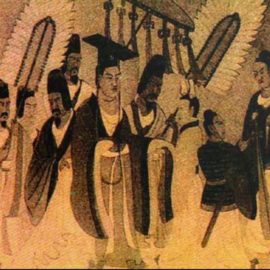

This article is an excerpt from the Shortform book guide to "Grant" by Ron Chernow. Shortform has the world's best summaries and analyses of books you should be reading.
Like this article? Sign up for a free trial here.
What’s Ron Chernow’s book Grant about? Why is Ulysses S. Grant’s life as president of the United States and general during the Civil War so fascinating?
In Grant, Ron Chernow assesses Grant’s role in the Civil War, his accomplishments as president, and his struggles with alcohol use. His aim is to restore Grant’s reputation, which was demolished due to corruption and scandals.
Read below for a brief Grant book overview.
Grant by Ron Chernow
Best known as the general who led the Union to victory over the Confederacy in the Civil War, Ulysses S. Grant has been widely misunderstood by mainstream historians, argues biographer Ron Chernow. According to Chernow, the mainstream narrative characterizes Grant as an inept heavy drinker whose success in the Civil War stemmed primarily from a numbers advantage and whose Presidency was marred by corruption and the failure of Reconstruction. But in his comprehensive 2018 biography book, Grant, Chernow seeks to correct this caricature by shedding light on Grant’s achievements as General of the Union, President of the United States, and a person fighting valiantly against an alcohol addiction.
As the Pulitzer Prize recipient for his 2010 biography on George Washington and the author of seminal biographies on Alexander Hamilton and John D. Rockefeller, Chernow has established himself as one of America’s preeminent historical biographers. Chernow’s historical expertise is evident throughout Grant, in which he weaves together evidence from interviews, private correspondence, and historical records to craft an encyclopedic account of Grant’s life and accomplishments.
Grant’s Military Career
Chernow writes that Grant’s military career spans from the Mexican American-War of the late 1840s, in which Grant served as a soldier under Major General (and future President) Zachary Taylor, to the pinnacle of the Civil War, in which Grant emerged victorious over Confederate General Robert E. Lee to effectively end the war. In this section, we’ll focus on Grant’s military tenure in the Civil War specifically, discussing how Southern secession spurred his return to service, how he displayed a cunning military mind as commander of Union troops, and finally how he protected ex-slaves following Lincoln’s Emancipation Proclamation.
Grant’s Opposition to Secession
To understand Grant’s return to the military—which occurred after drinking allegations led him to resign in 1854, as we’ll discuss later—Chernow first examines Grant’s reaction to the news that eleven Southern states had seceded from the Union between late 1860 and 1861, with these states declaring themselves the Confederate States of America and selecting Jefferson Davis as their President. According to Chernow, these secessions galvanized Grant to return to duty, as Grant maintained that secession was unconstitutional and traitorous.
In defense of this claim, Chernow appeals to passages from Grant’s own Memoirs, in which he reflected on the wave of secessions in January of 1861, including Florida, Mississippi, Alabama, Georgia, and Louisiana. Because the US purchased many of these states through its national treasury, Grant reasoned that they lacked the right to secede. Indeed, Chernow points out that Grant had a visceral response to representatives from Confederate states gathering in February of 1861, who declared themselves the Confederate States of America—interviews with witnesses stated that Grant called for all of the traitors to be hanged.
With his newfound zeal, Grant traveled to towns around Galena, Illinois—his hometown—to seek volunteers to join the military. And although it took some time for Grant to earn an official post, Chernow writes that he became a colonel of the Twenty-First Illinois Regiment in June, officially marking his return to military life.
Grant’s Strategic Savvy During the Civil War
After his return to the military, Grant was promoted to Major General of Volunteers in 1862, making him the second-highest general in the Western Theater (the land between the Mississippi River and the Appalachian mountains). Contrary to Grant’s critics, who allege Grant was closer to a reckless butcher than a savvy leader, Chernow argues that Grant was a cunning strategist and leader in the Civil War, both on and off the battlefield. Though Chernow cites varied evidence to defend this thesis, he focuses on two key examples: Grant’s military campaign in Vicksburg and his post-victory treatment of Confederates in Vicksburg and Appomattox.
Grant’s Consistent Concern for Freedmen
In addition to Grant’s strategic genius, Chernow maintains that Grant also exemplified compassion in his treatment of ex-slaves throughout the Civil War. Specifically, Chernow argues that Grant consistently advocated for the fair treatment of ex-slaves, as shown by his development of “contraband camps” to care for former slaves and his commitment to letting them join the Union army.
First, Chernow points out that in November of 1862, following Congressional orders for Union armies to safeguard former slaves, Grant spearheaded the effort to establish “contraband camps”—encampments in which former slaves were paid for their labor (like harvesting crops and building cabins). Moreover, Grant supplied these freedmen with shelter, food, and clothing to effectively establish their own communities. As Chernow relates, Grant’s initiative even earned him praise from acclaimed Black abolitionist Frederick Douglass.
Additionally, Chernow relates that in April of 1863, Grant enthusiastically enlisted former slaves into the army as paid soldiers and urged his commanders to do the same, creating the first Black regiments in the Union army. Chernow argues that, in light of the entrenched racism present in the Union army, Grant’s insistence on allowing liberated slaves to join the military was momentous: By encouraging prejudiced Union troops to work alongside these ex-slaves, Grant began to uproot decades of ingrained racism among Northern soldiers.
Chernow contends that both of these actions flowed from Grant’s increasingly firm support for abolitionism. Chernow notes that, in Grant’s 1863 letter to Illinois Representative Elihu Washburne, he expressed an uncompromising conviction that reconciliation with the South could only occur after eradicating slavery, even going so far as to deem the war divine retribution for slavery.
Grant the President
After widespread success in the Civil War, Grant parlayed his post-war popularity in both Northern and Southern states into the presidency: In 1868, as the Republican nominee, Grant defeated incumbent Andrew Johnson (who became President after Abraham Lincoln’s assassination) to become the 18th President. In this section, we’ll analyze Grant’s legacy of Reconstruction—the era lasting from the Civil War’s end until 1877—which saw him attempt to defend civil rights for Black Americans while reconciling with the South. Additionally, we’ll consider the corruption that marred Grant’s Presidency and Chernow’s explanation that it arose from Grant’s overly trusting nature.
Grant’s Civil Rights Activism
According to Chernow, Grant remained steadfastly committed to protecting civil rights for freedmen in the aftermath of the Civil War. He argues that Grant’s work as President was essential for safeguarding Black citizens’ civil rights and helping them transition out of slavery. And although Chernow lists various examples of Grant’s activism, he mainly focuses on three key instances: Grant’s support for the Fifteenth Amendment, his implementation of the Ku Klux Klan (KKK) Act, and his decision to fund the Bureau of Education.
Grant’s Attempts at Domestic and International Conciliation
Chernow further argues that, in addition to his civil rights activism, Grant’s Presidency was marked by attempts at international and domestic conciliation, though these attempts weren’t always successful. To understand Grant’s conciliatory efforts, we’ll focus on two key areas: his successful attempts at conciliating with Great Britain post-Civil War, and his unsuccessful attempts at conciliating with the South.
International Conciliation With Great Britain
Chernow contends that Grant successfully alleviated post-war tensions with Great Britain by savvily navigating the so-called Alabama claims. These claims, he points out, arose during the Civil War, in which five warships constructed in Great Britain—most famously the CSS Alabama—were used by the Confederacy to fight the Union despite Britain’s alleged stance of neutrality. After the Civil War, Northern politicians demanded compensation for damages wrought by the warships, with Senator Charles Sumner proposing a radical $2 billion dollar settlement.
As Chernow relates, Grant handled the situation masterfully: Through his secretary of state, Hamilton Fish, he established an international committee composed of American and British members to arbitrate the Alabama claims. As a result of this arbitration, Britain admitted fault and agreed to a $15.5 million settlement. In Chernow’s assessment, Grant won the admiration of the American public by getting Britain to admit culpability, but he also avoided confrontation with Great Britain by allowing an international tribunal to arbitrate the claims. He thus tactfully resolved a situation that could have resulted in domestic upheaval or international conflict, setting the stage for peaceful international arbitration in the future.
Attempted Domestic Conciliation With the South
Despite Grant’s success in international diplomacy, he was unable to attain similar success domestically. According to Chernow, Grant consistently sought to reconcile the North and the South post war, but failed to do so.
Grant’s goal of reconciliation, Chernow points out, was evident before he took office—as lieutenant general post-Civil War, Grant threatened to resign when President Andrew Johnson declared his intent to prosecute Lee and other Confederate leaders for treason. Grant understood that prosecuting Lee would not only violate the Appomattox surrender agreement, but it would also incite further unrest in the South. Not wanting to oppose Grant, President Johnson decided to avoid prosecuting the Confederate leaders.
Nonetheless, Chernow argues that by the end of Grant’s presidency, the divide between North and South was irreconcilable. He alleges that Grant’s aggressive strategy to defeat the KKK—which involved consistently stationing federal troops in Southern states—led Democratic Congressmen to regain control of Southern states, which viewed the presence of federal troops as an attack against states’ freedoms. As leaders of the South, these Democrats cast the Civil War as an act of “northern aggression” and an assault on states’ rights, downplaying the role slavery had played in causing the war. According to Chernow, this increased Democratic control of the South led to the end of Grant’s Reconstruction era in 1877.
Grant’s Political Naivety and Susceptibility to Corruption
Although Grant showed political poise in settling the Alabama claims, Chernow contends that his lack of political experience was evident elsewhere. In particular, he argues that Grant’s gullible nature blinded him to corruption by those he trusted, revealing a consistent political naivety. To show as much, we’ll focus on two scandals that marred Grant’s presidency: the so-called Whiskey Ring and Indian Ring scandals.
Scandal #1: The Whiskey Ring
The Whiskey Ring scandal, discovered in 1875, concerned two of Grant’s close friends: General John McDonald, whom Grant nominated as head of internal revenue for Arkansas and Missouri, and Orville Babcock, Grant’s personal aide. For several years, McDonald had colluded with whiskey distillers in St. Louis, helping them duck taxes and pocketing half the difference himself. And as Grant’s aide, Babcock supported McDonald both by steering attention away from the ring, and by later providing McDonald a heads-up before federal agents raided the distilleries.
However, although Secretary of the Treasury Benjamin Bristow showed Grant damning evidence against McDonald and Babcock, Grant refused to believe his friends had betrayed him. As Chernow relates, Grant even gave a deposition in 1876—an act unprecedented for a sitting President—to testify to Babcock’s honesty and to express his unwavering belief in Babcock’s innocence. According to Chernow, this deposition was crucial in Babcock’s acquittal, even though telegrams had been seized effectively proving Babcock had colluded with McDonald. So though Grant didn’t participate in the scandal himself, his naivety led to the acquittal of one of its key members.
Scandal #2: The Indian Ring
In the wake of the whiskey ring, Grant’s presidency fell victim to another scandal, known as the Indian Ring, that again showcased Grant’s vulnerability to corruption. Chernow writes that, in March 1876, a House committee collected evidence that Grant’s Secretary of War, William Belknap, had committed an impeachable offense by taking bribes to appoint individuals to valuable Indian traderships (trading posts whose owners had the right to sell goods to Native Americans) to the tune of $6,000 a year.
Grant’s short-sightedness was evident on March 2, when Belknap (who had caught wind of the looming impeachment hearing against him) approached him and asked to resign. According to Chernow, though Grant knew of the investigation against Belknap, he carelessly accepted his resignation, making him a private citizen and throwing into question whether it was legal to impeach him. Grant thus unwittingly shielded Belknap, and although the Senate attempted to convict Belknap, the vote failed because many Senators believed they couldn’t convict a private citizen.
Grant’s Lifelong Struggle With Unhealthy Alcohol Use
In spite of Grant’s achievements as General and as President, his reputation was tarnished by accusations of rampant alcohol misuse. Chernow maintains that many historical accounts specifically emphasize these accusations, suggesting Grant drank recklessly and was controlled by intemperate desires. But, according to Chernow, this portrayal is misguided—Grant, he argues, fought valiantly against his tendency toward unhealthy alcohol use and attained victory over this tendency in his final years. In this section, we’ll examine Chernow’s account of Grant’s alcohol use, outlining its roots in Grant’s military career, how Grant recognized his addiction, and how he conquered it in his final years.
The Roots of Grant’s Alcohol Misuse
According to Chernow, Grant’s struggles with alcohol misuse had deep roots in his family and his early military service. Chernow points out that, per correspondence from Grant’s father, Jesse Root Grant, Grant’s grandfather misused alcohol. Because alcohol misuse is partially hereditary, this suggests Grant might have been genetically predisposed to unhealthy drinking patterns.
Chernow contends that the first indications of Grant’s struggles with alcohol misuse occurred during his time as an officer in the Mexican-American War. According to Grant’s friend, Richard Dawson, Grant drank heavily after the war, to the point that his drinking had visibly impacted his health. But, Chernow writes, Grant’s struggles were amplified in 1854 when he was stationed at Fort Humboldt—an isolated fort in Northern California, where Grant was separated from his family and grew increasingly depressed. Interviews with Grant’s fellow soldiers reveal that, during this time, Grant frequently drank to the point of sickness.
However, Grant’s unhealthy alcohol use reached a new low in April 1854. Chernow writes that Grant’s commanding officer—Colonel Robert Buchanan—admonished Grant after a severe drinking incident, telling Grant that he would compel Grant’s resignation if it occurred again. Then, when Grant later turned up intoxicated at his company’s pay table, Colonel Buchanan allegedly told Grant he could resign or face a court-martial and possible dishonorable discharge. Thus, on April 11, 1854, Grant resigned his post as captain, leaving the military.
Grant’s Recognition of His Addiction
Although Grant’s unhealthy alcohol use had debilitating effects, Chernow argues that Grant wasn’t the passive victim of his addiction, but actively recognized it and fought against it. To show as much, Chernow points to Grant’s early membership in temperance movements and his later reliance on his aide in the Civil War, John Rawlins, to enforce his sobriety pledge.
As Chernow relates, Grant joined the Sons of Temperance—a national brotherhood advocating abstinence from alcohol—in the late 1840s, even organizing his own division in Sackets Harbor, where he was stationed. In addition to taking a vow of sobriety, Grant’s membership required him to wear a white sash publicly showing his association with the temperance movement. According to an interview with a friend, Grant joined the Sons of Temperance because he was convinced that abstinence was the only protection from his tendency to misuse alcohol.
In addition to joining the temperance movement as a young soldier, Grant also recognized his struggles with unhealthy alcohol use as a colonel at the beginning of the Civil War. Chernow writes that in 1861, Grant appointed John Rawlins—a steadfast advocate of temperance—as his chief of staff, and allowed Rawlins to enforce Grant’s vow of sobriety until the war ended. By making this pledge to Rawlins, Grant showed a willingness to confront his alcohol misuse rather than downplaying its significance.
Grant’s Eventual Victory Over Unhealthy Alcohol Use
Despite Grant’s lifelong struggles with alcohol misuse, Chernow maintains that Grant conquered his addiction during and after the Presidency, before his death in 1885.
Chernow points out that, during Grant’s Presidency, Grant was known to refuse any alcohol at state dinners, and on New Year’s Day, he ordered coffee to be served in lieu of alcohol. Further, according to correspondence from Admiral Daniel Ammen (one of Grant’s closest friends), Ammen never once witnessed Grant inebriated during his eight years as President. And more generally, Chernow argues that the lack of credible accusations of binge drinking during Grant’s tenure as President suggests Grant had remained sober.
As evidence that Grant continued to conquer his unhealthy alcohol use post-presidency, Chernow points to Grant’s renewed association with temperance movements. In 1880, Grant reportedly met with temperance advocates in Florida, formally declaring his belief that alcohol was the root of evils like poverty and crime. However, the strongest evidence that Grant stayed sober stems from his personal butler, ex-slave Harrison Terrell. According to newspaper interviews with Terrell, who likely spent more time with Grant than anyone but Grant’s wife, Grant exclusively drank in moderation later in life.
Taken together, Chernow argues, these pieces of evidence indicate that Grant overcame his addiction toward the end of his life. And in Chernow’s assessment, for the man who had conquered the Confederates and reunited the country, the victory over unhealthy drinking might have been Grant’s greatest victory of all.

———End of Preview———
Like what you just read? Read the rest of the world's best book summary and analysis of Ron Chernow's "Grant" at Shortform.
Here's what you'll find in our full Grant summary:
- A biography of Ulysses S. Grant that paints him in a new light
- Grant's role in the Civil War and as president of the United States
- How Grant fought valiantly against alcohol addiction






